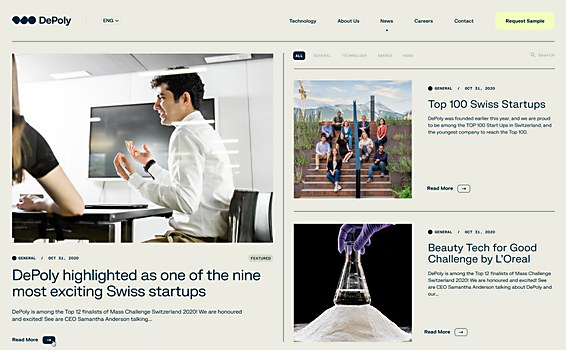Responses by Petar Stojekovic; founder, chief executive officer and creative director; FIFTYSEVEN.
Background: The new website and branding for Sion, Swizterland–based chemical manufacturing company DePoly were initially launched in 2022 with the purpose of raising its brand and product awareness and attracting investors. The goal was to elevate the idea and technology behind enhanced recycling by educating users and potential investors while emphasizing its benefits over current industry practices that harm the environment.
The recycling industry has been around the marketing circuit for decades, which meant that breaking away from standardized messaging was both difficult and somehow a little dangerous. But for us, it was exactly an opportunity to do something different and original. We founded our approach on designing the correct visual and narrative balance between “technologically advanced” and “approachable.” This balance helps DePoly stand out in its industry while still being a part of it; simultaneously, it draws attention to the devastating environmental impact of modern recycling practices.
This direction crystalized into a clean, non-invasive look, with a direct and sophisticated brand and website language. Using a dignified, earthy color palette, this aesthetic speaks to the refinement of DePoly’s technology and evokes its connection to nature.
Design core: Each page provides a comprehensive storytelling narrative experience with fluid motion and a clean editorial aesthetic. We created custom 3-D visuals using simple, recognizable models with clean, uniform textures, complemented by a natural, organic feel. Through this, we achieved an original, authentic on-brand web experience, which we consider the most important feature and element of this project.
Favorite details: The aesthetics of the website. Taking such a radical approach compared to the standards of the industry from which DePoly comes enabled us to unite the opposite connotations of “recycled” and “pristine” in a single breath, while maintaining enough expressive range to tell the story of transformation and explain DePoly’s technology. In other words, our main theme was “recaptured potential”—or “recycled potential,” if you will. This is our greatest pride as we found that unique angle of the theme and visual vocabulary, and we were able to convey DePoly’s ethos in an authentic way.
Challenges: Crafting a cohesive, non-linear experience with a narrative arc that’s easy to follow. Our approach centered around keeping the message clear and the story linear, while cyclically adding more context as the user progresses through the pages. It had to cover the impact of current recycling practices and ease the user into DePoly’s approach. Establishing trust in the brand as a scientific authority, the narrative had to make the main CTA—contacting DePoly—a natural next step.
Time constraints: The project was completed in a record time of a little less than four months, including branding, 3-D visuals, and web design and development. This is a worthy culmination of the whole team’s experience, but above all, it reflects the client giving us complete freedom and trust.
New lessons: When it comes to visual narrative, sometimes the simplest approach has a very powerful, immersive and on-brand effect.
Navigation structure: As the main CTA, the sample request form serves as a bridge between potential investors and DePoly. As a direct means of establishing credibility, it enables licensed laboratories to verify the quality of the new technology themselves by testing the samples DePoly provides. We paid special attention to the “request sample” button to be unobtrusive but clearly visible in the upper-right corner of every page, and the form itself is extremely responsive and comes in and out from the side with a single click. This way, filling out the form doesn’t interrupt the experience and lets the user get back to the content without losing their place on the page.
Technology: For web UX and UI designs, we used Figma, which let us easily get up to speed and set up the entire design and copy narrative with DePoly’s founders. For the 3-D visual execution, we used Cinema 4D and the OctaneRender engine. For the website front-end development, we used Framer Motion, GSAP, Netlify for hosting and fast CDN loading, React, progressive web apps, Sanity for the CMS, and SCSS.

















